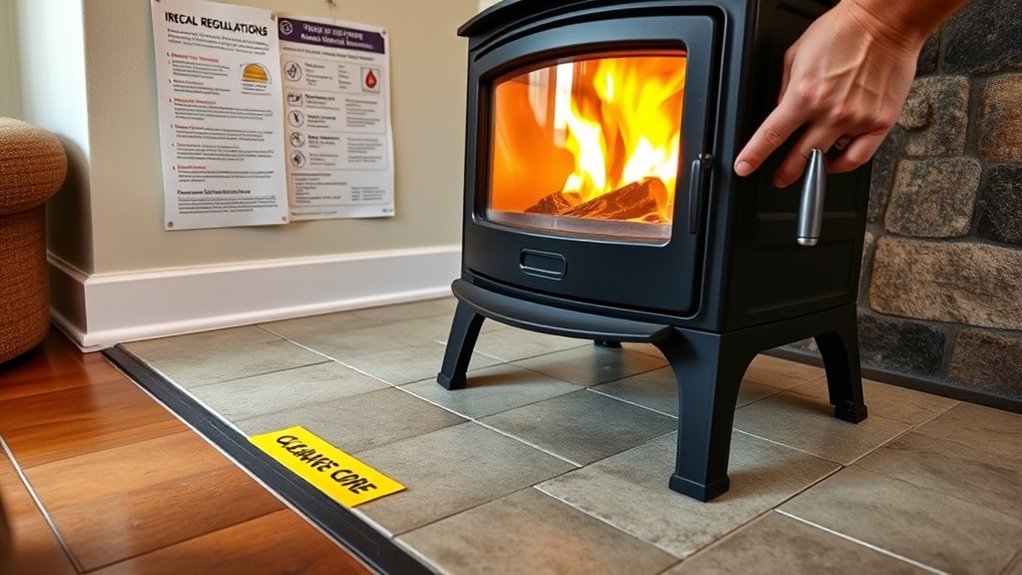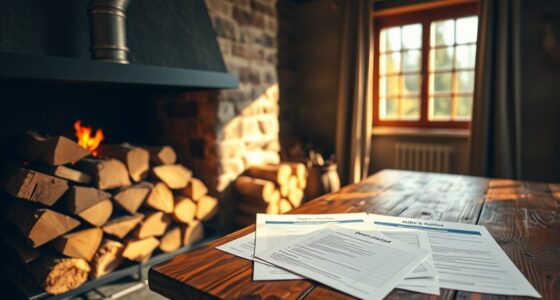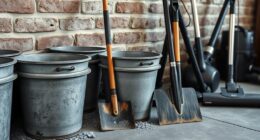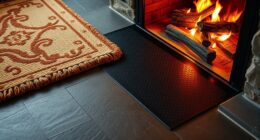To install a wood stove legally, you need to follow your local building codes, which specify clearance distances, support, and fireproofing standards. You must obtain permits and pass inspections to ensure safe venting, proper chimney height, and correct placement away from combustible materials. Environmental regulations also require using certified stoves and safe fuel types. Following these rules helps prevent fire hazards and legal issues—continue exploring for detailed steps to keep your installation safe and compliant.
Key Takeaways
- Obtain necessary permits and submit detailed installation plans to local building authorities for approval.
- Ensure minimum clearance distances from walls, furniture, and combustible materials as specified by regional building codes.
- Install smoke and carbon monoxide detectors according to local safety regulations, with proper placement and regular testing.
- Use approved fireproof shields, hearth pads, and support brackets to meet fire safety standards and chimney support requirements.
- Schedule inspections post-installation to verify compliance with local codes, ventilation standards, and safety devices.
Understanding Local Building Codes and Permits
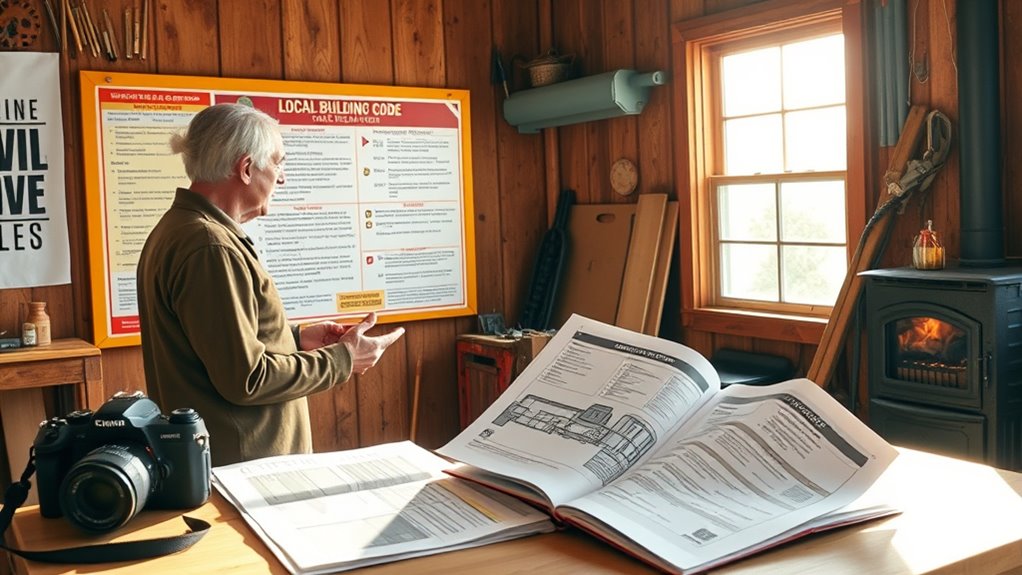
Understanding local building codes and permits is essential before installing a wood stove, as these regulations guarantee your safety and legal compliance. Building codes specify minimum clearance distances between your stove and combustible materials like walls and furniture, reducing fire risks. You’ll need to obtain permits from municipal or county authorities before starting installation, ensuring your project aligns with local rules. Once installed, an inspection is often required to verify that your stove and chimney meet safety standards. Regulations may also specify approved fireproofing materials and construction methods, often referencing national standards like NFPA 211. Failing to follow these codes and permit requirements can lead to fines, insurance issues, or costly modifications later. Staying compliant safeguards both your home and peace of mind. Additionally, understanding building code requirements related to ventilation and emissions can help ensure your installation minimizes environmental impact and complies with health standards. It’s also important to stay informed about local environmental regulations that might affect wood stove use and emissions standards in your area. Moreover, familiarizing yourself with inspection procedures can facilitate a smoother approval process and address potential issues proactively. Furthermore, consulting with local building officials can provide clarity on specific regional requirements and help avoid delays.
Clearance Requirements and Safe Distances
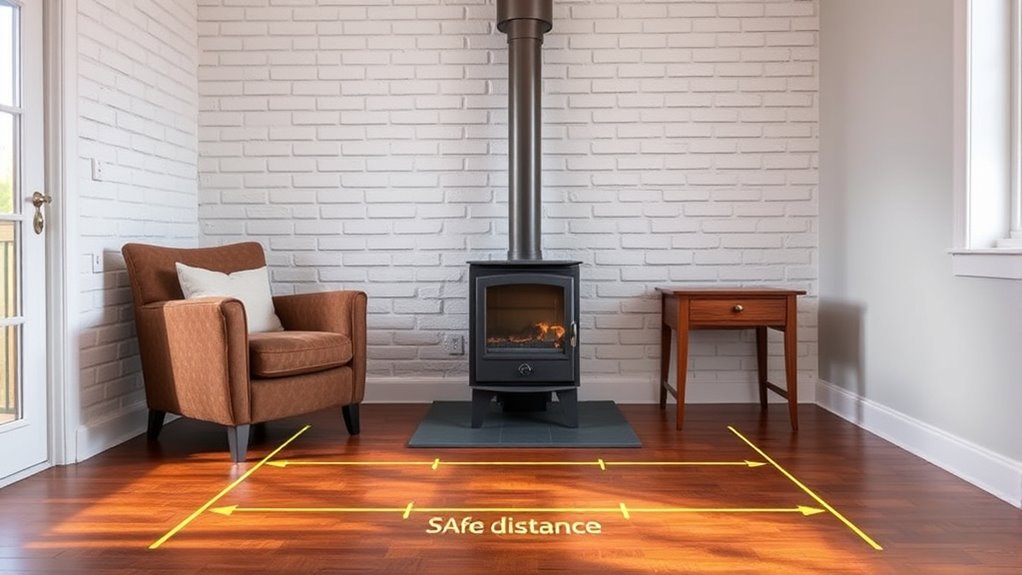
You need to keep a safe distance between your wood stove and nearby walls or furniture to prevent fires. Local codes usually require at least 36 inches of clearance from combustible walls and materials, but always check your specific regulations. Ensuring proper spacing helps keep your home safe while allowing your stove to operate efficiently. Additionally, identifying signs of spoilage in materials around the stove area can help prevent potential fire hazards. Being aware of electric power generation with bike generators can also provide alternative energy solutions during emergencies or power outages. Proper ventilation around the stove is also essential to prevent buildup of dangerous fumes and ensure safe operation. Maintaining proper fire safety awareness can further reduce risks associated with wood stove use.
Minimum Distance From Walls
Maintaining proper clearance between a wood stove and combustible walls is essential for safety and code compliance. The minimum distance from the stove to combustible walls is generally 36 inches, but some local codes may require up to 48 inches or more. To reduce clearances, you can install wall protection like fireproof shields, provided they meet local safety guidelines and installation standards. Certain jurisdictions may specify a minimum of 20 inches clearance without additional barriers, emphasizing the importance of following local codes. Always measure clearances from the stove’s front, sides, and rear to the nearest combustible surfaces. Regular inspections ensure these safe distances are maintained over time, helping you stay compliant and protect your home. Studies on optimal angles for pinball machines highlight how proper positioning can also enhance safety and performance. Additionally, consulting local fire safety regulations ensures your installation meets all regional requirements and reduces fire hazards. Proper venting and clearance are also crucial in minimizing fire risks associated with wood stove use. Moreover, understanding Vetted – Icecream Hater preferences can inform safety priorities for households with diverse needs. Ensuring proper ventilation systems are installed can further mitigate the risk of carbon monoxide buildup and enhance overall safety.
Clearance From Combustible Materials
Clearance from combustible materials is a key factor in safe wood stove installation. Most building codes require a minimum clearance of 36 inches from the stove to combustible walls or furniture, but check your local regulations for specific distances. For flooring, fire safety standards typically mandate at least 18 inches of clearance unless you install floor protection like non-combustible hearths or pads. When installing chimneys and vent pipes, a minimum clearance of 2 inches from combustible materials is standard, though approved shielding can sometimes reduce this distance. Using wall protectors and insulation materials can decrease clearances by up to 66%, but it’s essential to stay within safety standards. Proper filtration systems are also important to ensure indoor air quality when operating a wood stove. Always consult local building codes and manufacturer guidelines to ensure proper clearance and safe chimney installation.
Fireproofing and Hearth Standards
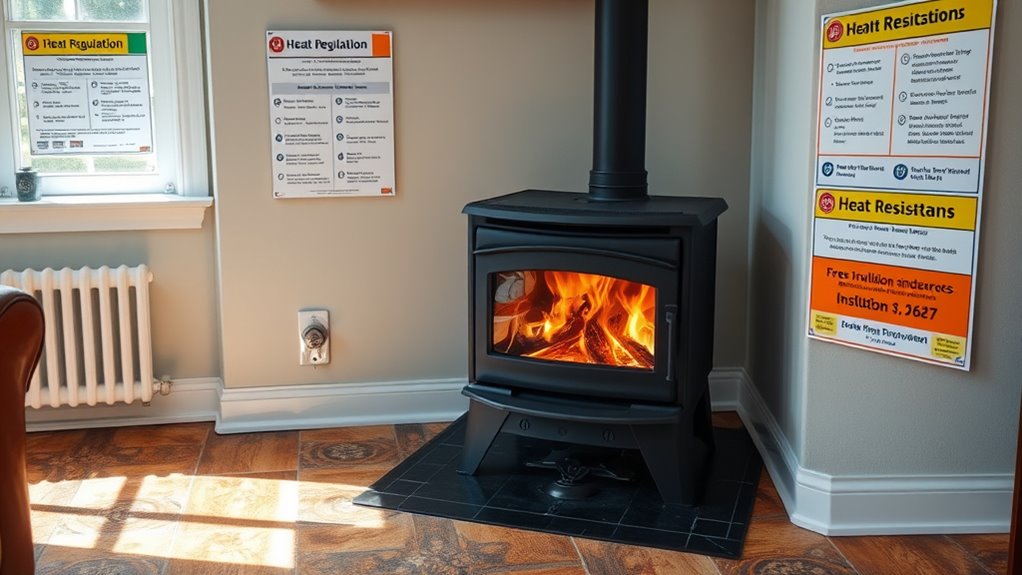
Fireproofing and hearth standards are essential for ensuring safe wood stove installation. You must install a non-combustible hearth pad that extends at least 18 inches beyond the stove’s front and sides to prevent fire hazards. Behind the stove, fireproofing materials like 24-gauge sheet metal or 1/2-inch non-combustible insulating boards are required to shield combustible walls from high temperatures. Walls behind the stove should maintain a minimum clearance of 20 inches when protected with approved non-combustible materials, aligning with local fire safety codes. Hearth construction often involves fire-resistant barriers such as brick or stone that meet fireproofing standards. All installations must adhere to local building codes, ensuring proper material ratings, thicknesses, and clearances for ideal safety during stove operation. Using high-quality fire-resistant materials can further enhance safety and compliance with regulations. Regular inspections and maintenance are crucial for maintaining fire safety standards, and choosing materials with proper fire resistance ratings helps ensure long-term safety.
Chimney and Ventilation Regulations

You need to guarantee your chimney meets height standards, extending at least 3 feet above the roof and 2 feet higher than nearby structures. Proper ventilation is essential to prevent dangerous gases like carbon monoxide from building up indoors. Additionally, follow clearance and support rules to keep your chimney safe and secure against heat and wind. Ensuring proper decoherence of your chimney system can also help maintain optimal airflow and safety. Regular inspection and maintenance are crucial to identify potential issues early and ensure compliance with local regulations for chimney installation. Incorporating safety features can further enhance the overall security and effectiveness of your chimney system.
Chimney Height Standards
To guarantee safe and efficient operation of your wood stove, the chimney must extend at least 3 feet above the roof exit point. This ensures proper draft, ventilation, and safety standards. Additionally, the chimney should be at least 2 feet higher than any nearby roof or structure within a 10-foot radius to prevent downdrafts. Compliance with building codes and installation regulations is essential for safety and performance. Proper chimney height reduces creosote buildup and minimizes smoke re-entry. Here’s a visual to guide you:
| Height Requirements | Location Context | Safety Purpose |
|---|---|---|
| 3 feet above roof | Roof exit point | Ensures proper draft |
| 2 feet higher than nearby structures | Within 10 feet radius | Prevents downdrafts |
| Meets building codes | Local regulations | Ensures compliance |
| Follows manufacturer specs | Ventilation standards | Maintains safety standards |
| Adequate roof clearance | Installation regulations | Reduces creosote buildup |
Ensuring proper chimney height standards is vital for optimal performance and safety. Proper adherence to installation regulations and understanding venting requirements helps ensure your wood stove operates efficiently and remains safe for your household.
Proper Ventilation Requirements
Proper ventilation is crucial for safe and efficient wood stove operation, requiring the installation of a certified chimney or vent system made from non-combustible materials. The chimney must extend at least 3 feet above the roof and be positioned at least 2 feet higher than nearby structures within 10 feet to guarantee proper draft and air circulation. A vent pipe connects the stove to the chimney, facilitating safe exhaust of smoke, gases, and carbon monoxide. Adequate outside air intake is necessary, especially in airtight homes, to prevent dangerous carbon monoxide buildup. Regular inspection and maintenance of the vent pipe and chimney are indispensable to detect blockages, creosote buildup, or leaks that could compromise safety and ventilation. Proper venting safeguards your home and ensures ideal stove performance. Additionally, understanding building codes and regulations can help ensure your installation meets all safety standards. Ensuring proper ventilation systems are correctly installed and maintained is vital for both safety and efficiency.
Clearance and Support Rules
Maintaining correct clearance and support for your chimney and ventilation system is essential for safe and efficient wood stove operation. Local installation regulations typically require a minimum clearance of 36 inches from the stove to combustible surfaces like walls and furniture, unless approved protective barriers are used. Chimney supports must be securely anchored and capable of supporting the weight of the entire system, especially for structures over 4 feet or in high wind areas. Support brackets and braces should be installed every 3 to 4 feet to prevent sagging and ensure proper alignment, following building codes. Keep ventilation and chimney piping at least 2 inches from combustible surfaces to minimize fire hazards. Adhering to these clearance and support rules enhances fire safety and system durability.
Inspection and Approval Processes
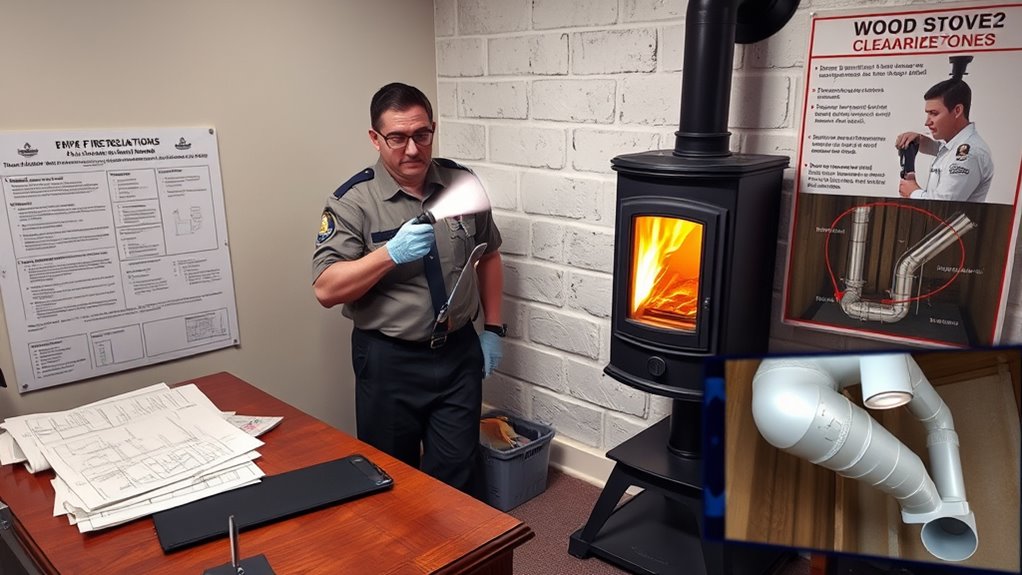
Have you checked whether your local building department requires a permit before installing your wood stove? Most jurisdictions do, and obtaining permits involves submitting plans for review to ensure compliance with building codes and safety regulations. After installation, an inspection is typically required to verify proper venting, clearance from combustibles, and correct chimney support. Fire and building inspectors assess the setup for safety compliance, often checking that the stove meets manufacturer specifications. If your installation passes inspection, you’ll usually receive an approval or sticker, allowing legal use of the stove. Failing to get permits or pass inspections can lead to fines, required modifications, or even insurance issues. Following the inspection process guarantees your installation adheres to local regulations and keeps your home safe.
Environmental and Emissions Regulations
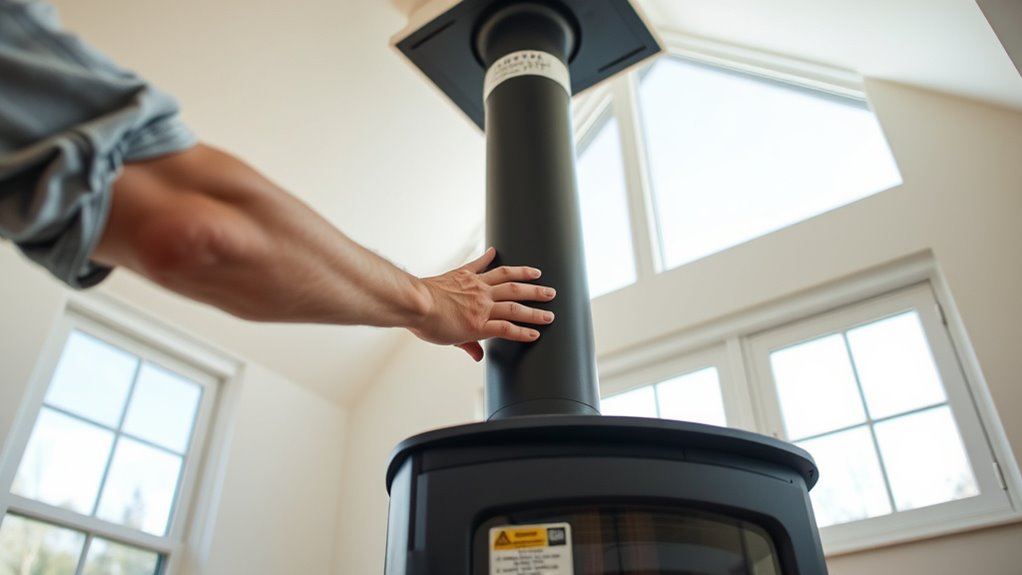
Are you aware that environmental and emissions regulations play a vital role in wood stove installation? These regulations ensure your stove operates within EPA-certified standards, which restrict emissions of particulate matter to 2.0 grams per hour or less. Many regions enforce strict emissions standards to protect air quality, requiring you to burn dry, seasoned wood and avoid wet wood, which produces excess smoke. Some areas implement burn bans during high pollution days, limiting stove use temporarily. Regular chimney inspections and maintenance are crucial to keep emissions low and prevent smoke buildup. Staying compliant with environmental regulations not only helps you avoid fines but also contributes to cleaner air and a healthier environment. Always check local rules to ensure your stove meets all emissions and environmental standards.
Safety Devices and Detectors Compliance
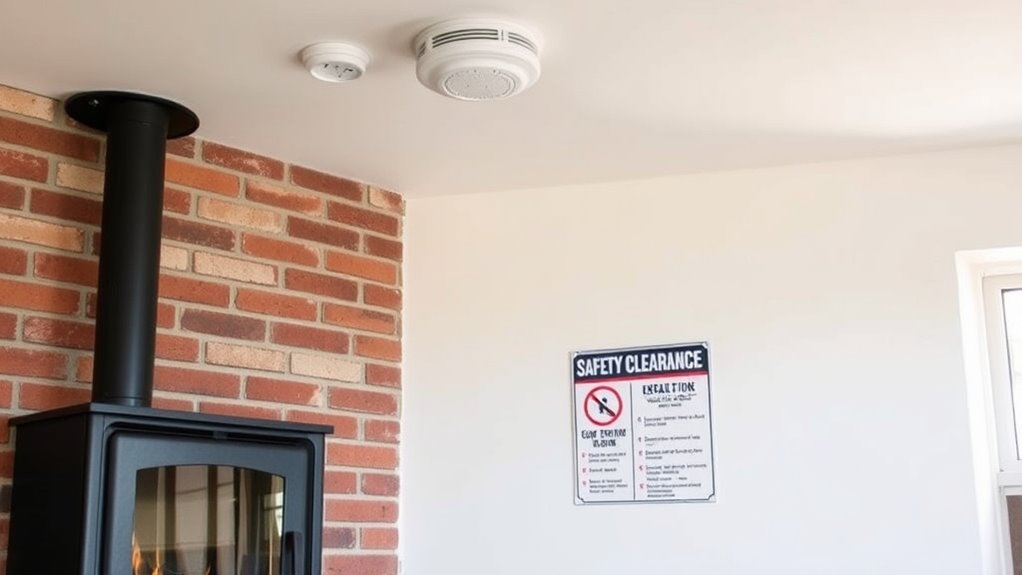
Installing smoke detectors and carbon monoxide alarms near your wood stove is a essential safety requirement enforced by local building codes. Proper detector placement is indispensable; smoke detectors should be outside sleeping areas and on every home level, including near the stove, while CO alarms must be in areas with combustion appliances. Ensuring safety compliance means following installation regulations, which often include interconnected detectors that activate all alarms simultaneously during an emergency. Regular maintenance is critical—test alarms frequently, replace batteries annually, and swap out detectors every 7-10 years or per manufacturer instructions. By adhering to these regulations and maintaining your safety devices, you considerably reduce risks, protect your household, and meet local building code standards for safe wood stove operation.
Restrictions on Fuel Types and Usage
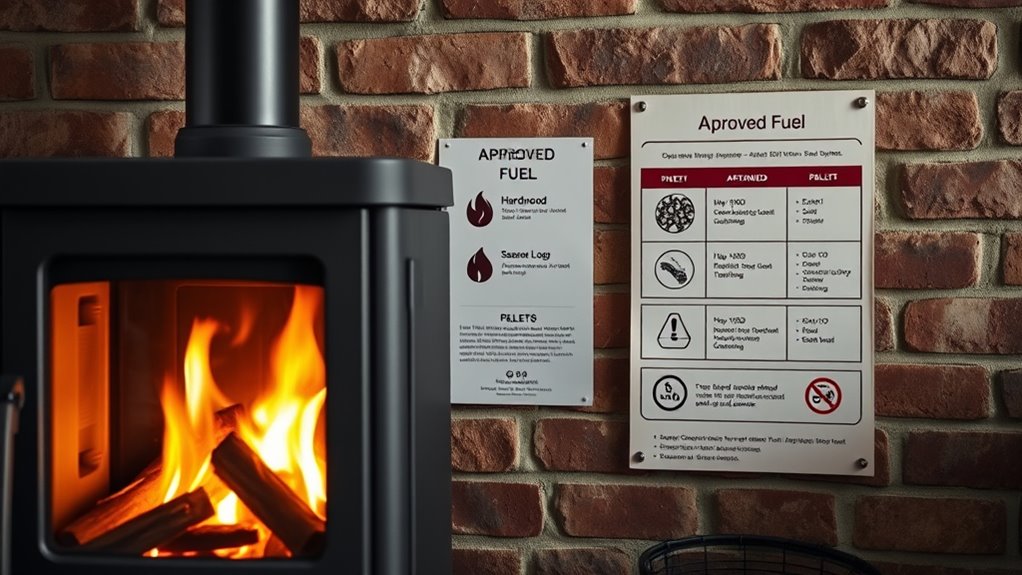
Did you know that local regulations often restrict the types of fuel you can burn in your wood stove? To meet burning regulations and emission standards, you must use approved fuel types like seasoned hardwood with less than 20% moisture. Many areas ban fuels such as trash, treated wood, or painted wood to prevent toxic emissions and fire hazards. During air quality alerts, burning might be prohibited altogether, aiming to improve air quality.
| Fuel Type | Allowed or Banned |
|---|---|
| Seasoned Hardwood | Allowed, preferred for efficiency |
| Banned Fuels | Trash, treated or painted wood |
| Approved Fuels | Natural gas, specific pellet grades |
| Disallowed Fuels | Coal, other solid fuels |
Post-Installation Inspections and Maintenance Checks
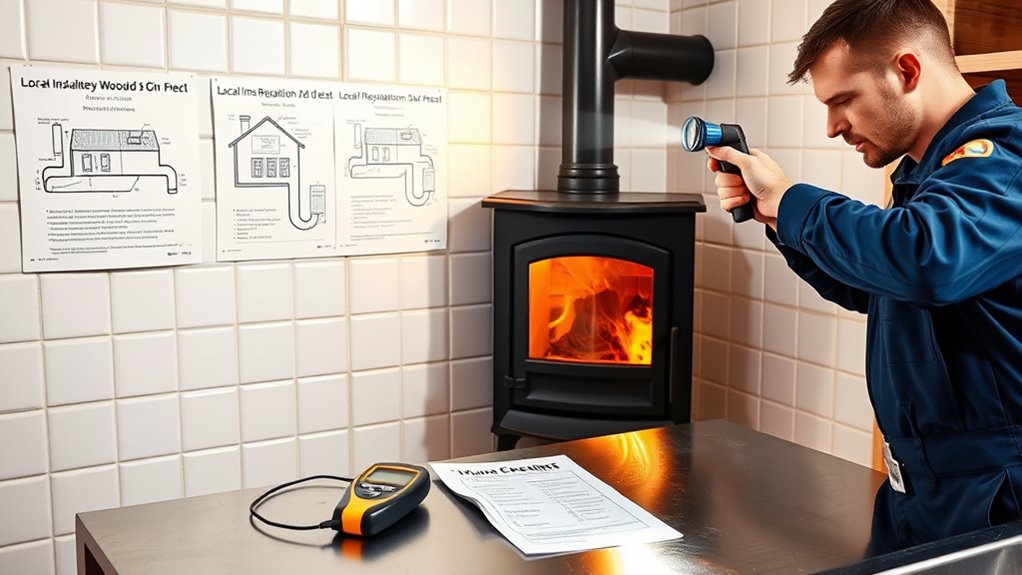
After completing your wood stove installation, it’s vital to have it inspected by qualified officials to verify it meets all safety, building, and manufacturer standards. An inspection ensures your stove complies with local code standards and fire safety regulations. During maintenance checks, examine chimney joints, flue liners, and stove connections for corrosion, cracks, or blockages. Routine inspections should also confirm safety devices like smoke and carbon monoxide detectors are functioning properly and correctly positioned. Schedule annual professional inspections to detect creosote buildup, which can cause chimney fires if left unchecked. Obtaining certification or an inspection report from inspectors confirms your installation’s compliance, providing peace of mind and ensuring your stove operates safely and efficiently over time.
Frequently Asked Questions
What Are the Requirements for Installing a Wood Burning Stove?
You’re wondering what it takes to install a wood-burning stove. First, make sure you choose an EPA-certified stove that meets federal standards. You need to get the necessary permits before installation and follow clearance requirements—usually at least 36 inches from combustible materials. Proper ventilation, like chimneys or flues, is essential for safety. Finally, expect a local inspection after installation to confirm everything complies with safety and building codes.
What Is the Code for a Wood Stove?
You’re asking about the code for a wood stove. Typically, it requires that your stove be listed and approved by recognized testing laboratories like UL, ETL, or CSA. You’ll also need to follow clearance distances from combustible materials, usually 18 to 36 inches, and install proper venting systems per NFPA 211 standards. Additionally, local permits and safety devices like smoke and carbon monoxide detectors are often mandatory for compliance.
What Are the Clearances Regulations for Wood Stove Installation?
Did you know that proper clearance from a wood stove to combustible surfaces can reduce fire risk by up to 66%? You should maintain a minimum of 36 inches from your stove to walls, but this can be diminished with approved protective barriers. Always check your local codes, which often require at least 20 inches without protection, and measure from the stove body to ensure safety and compliance.
Do You Need a Permit to Install a Wood Stove?
You need a permit to install a wood stove because it guarantees your safety and compliance with local laws. Without it, you risk fines, insurance issues, or having to remove the stove later. Check with your local building department or fire authority first, as requirements vary. They’ll guide you through the process, including inspections and necessary certifications, making sure your installation is safe and legal.
Conclusion
Following your local regulations guarantees your wood stove is safe and efficient. Did you know that improper installation can increase fire risks by up to 80%? By understanding building codes, clearance standards, and maintenance requirements, you protect your home and the environment. Stay compliant with inspections and use approved fuel types. Investing time in proper installation and regular checks not only keeps your family safe but also helps reduce emissions and saves you money in the long run.

